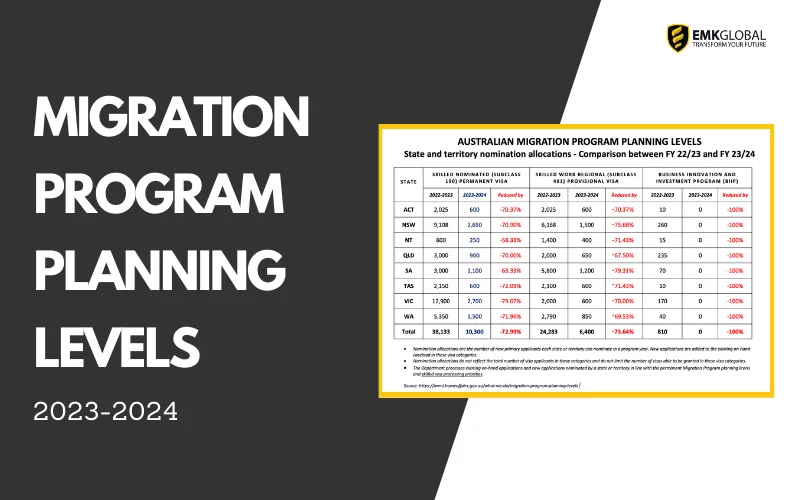On 9 May 2023, the Australian Government announced that the planning level for the 2023-24 permanent Migration Program will be set at 190,000 places.
The 2023-24 Migration Program has been designed to address persistent and emerging skills shortages and support the transition to a net-zero emissions economy by attracting specialist skillsets that are difficult to find or develop in Australia. The Program has the following composition:
- Skill stream (137,100 places) – this stream is designed to improve the productive capacity of the economy and fill skill shortages in the labour market, including those in regional Australia.
- Family stream (52,500 places) – this stream is predominantly made up of Partner visas, enabling Australians to reunite with family members from overseas and provide them with pathways to citizenship. Of this stream:
- 40,500 Partner visas are estimated for 2023-24 for planning purposes, noting this category is demand driven and not subject to a ceiling.
- 3,000 Child visas are estimated for 2023-24 for planning purposes, noting this category is demand driven and not subject to a ceiling.
- Special Eligibility stream (400 places) – this stream covers visas for those in special circumstances, including permanent residents returning to Australia after a period overseas.
Migration Program planning levels as announced as part of the 2022-23 and 2023-24 Federal Budgets
| VISA STREAM | VISA CATEGORY | 2022-23 PLANNING LEVELS | 2023-24 PLANNING LEVELS |
|---|---|---|---|
| Skill | Employer Sponsored | 35,000 | 36,825 |
| Skilled Independent | 32,100 | 30,375 | |
| Regional | 34,000 | 32,300 | |
| State/Territory Nominated | 31,000 | 30,400 | |
| Business Innovation & Investment | 5,000 | 1,900 | |
| Global Talent (Independent) | 5,000 | 5,000 | |
| Distinguished Talent | 300 | 300 | |
| Skill Total | 142,400 | 137,100 | |
| Family | Partner1 | 40,500 | 40,500 |
| Parent | 8,500 | 8,500 | |
| Child1 | 3,000 | 3,000 | |
| Other Family | 500 | 500 | |
| Family Total | 52,500 | 52,500 | |
| Special Eligibility | 100 | 400 | |
| Total Migration Program | 195,000 | 190,000 |
1 For 2023-24, delivery of the Partner and Child visa categories are demand driven, with indicative planning levels only.
Program size and composition
The size and composition of the Migration Program is set each year alongside the Australian Government’s Budget process.
To inform the planning levels and policy settings of the 2023-24 Migration Program, consultation occurred widely with state and territory governments, representatives of academia, industry, unions and community organisations.
When planning the Migration Program, the Australian Government considers the following:
- Public submissions
- Economic and labour force forecasts
- International research
- Net overseas migration, and
- Economic and fiscal modelling.
2023–24 state and territory nomination allocations
Nomination allocations are the number of new primary applicants each state or territory can nominate in a program year. New applications are added to the existing on-hand caseload in these visa categories.
Nomination allocations do not reflect the total number of visa applicants in these categories and do not limit the number of visas able to be granted in these visa categories.
The Department processes existing on-hand applications and new applications nominated by a state or territory in line with the permanent Migration Program planning levels and skilled visa processing priorities.
| State | Skilled Nominated (Subclass 190) visa | Skilled Work Regional (Subclass 491) visa | Business Innovation and Investment Program (BIIP)* |
|---|---|---|---|
| ACT | 600 | 600 | 0 |
| NSW | 2,650 | 1,500 | 0 |
| NT | 250 | 400 | 0 |
| QLD | 900 | 650 | 0 |
| SA | 1,100 | 1,200 | 0 |
| TAS | 600 | 600 | 0 |
| VIC | 2,700 | 600 | 0 |
| WA | 1,500 | 850 | 0 |
| Total | 10,300 | 6,400 | 0 |
Below is a comparison of the 2023–24 state and territory nomination allocations against the 2022–23 state and territory nomination allocations. In summary, there has been a drastic decline of more than 70% in this financial year’s allocation number as compared to the previous year.

Source: Department of Home Affairs
See more: https://immi.homeaffairs.gov.au/what-we-do/migration-program-planning-levels


